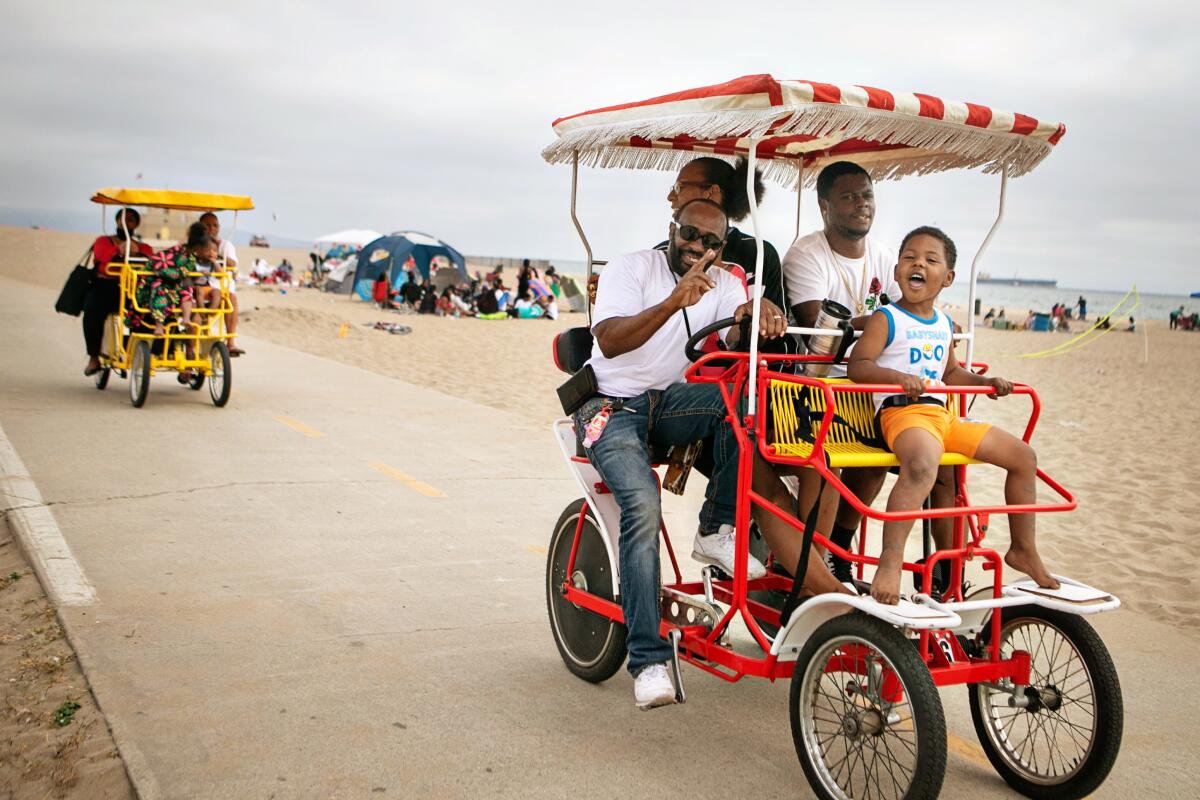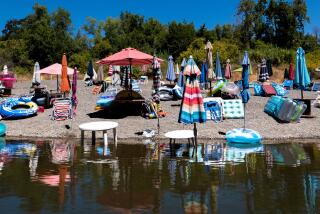The beach is there for all of us — we just have to get there

- Share via
When I first moved to Los Angeles in 2006, I imagined that I’d be going to the beach all the time.
I changed the background of my Myspace profile to a picture of Venice Beach palm trees at sunset as part of my preparations to live out the sun-drenched California fantasy that brings so many people to this state. Obviously, I would get into surfing. The only question was how good would I be.
Fifteen years later, I have still never surfed, and my fantasy of a beachy lifestyle has run aground on a hard reality. The coast exists for all of us, and our right to beach access enjoys greater protections here than in almost any other state. But first, you have to get there.
In the quadratic equation of distance, parking, traffic and transfers we use to determine our every course of action across this city, the beach is one of the hardest to solve.
If you wake up too early, or drive too far out, you might be exhausted when you get there. If you wake up too late, you’ll probably pay much more to park and have to go much farther to find a spot. If you pay too much to park, you’ll feel ripped off if you leave early. If you don’t pay to park you’ll exhaust yourself spending hours circling.
If you take the Expo line to Santa Monica, you can avoid all that. But then you’ll be at Santa Monica Beach, one of the most crowded tourist attractions in the city.
At least 12 Metro bus lines run to the beach, and there’s also a county-run beach bus that you can reserve in advance with stops in San Gabriel Valley, the Antelope Valley, San Fernando Valley and East Los Angeles. But it can be a difficult ride if you’re carrying a surfboard, cooler, tent or chairs.
Then there’s the long, sweaty hike across hot sand as you attempt to triangulate via lifeguard and cellphone tower where your friends and family are. Even then, the fickle whims of the marine layer might blot out the sun and leave you shivering.
This is why I believe packing a morning picnic for the beach in Los Angeles is utter folly. Get some food, coffee and water before the journey, or you might never make it.
The beach exerts an upward influence on all of our rents and home prices, and we all pay for our proximity to it in some way. At least 80% of Californians live within an hour’s drive of a beach. According to a recent UCLA survey, the average cost for traveling to and from the beach is $22.09 — not including the cost of parking, food and activities.
Homeowners engineer a myriad of ways to block access to our beaches, erecting fake no-parking signs, painting curbs red, installing their own gates and staircases and hiring private security. The California Coastal Commission fights back constantly, but there are less than a dozen enforcement officers for the whole state, and a caseload of more than 2,000.
“Once you get to Malibu and park your car, you’re now allowed to be there. You should feel comfortable,” said Linda Locklin, director of the commission’s beach access program. “But the fact is you have so many roadblocks and pinch points on your way out there.”
The pandemic brought the inequities of beach access into sharp focus. Beach parking lots were closed for months, during which only those in affluent, mostly white communities near the beach had ready access.
It was a reminder of the coast’s history of segregation, when there were only two beaches that Black people could visit: Inkwell Beach and Bruce’s Beach. Anyone at Inkwell Beach who attempted to wade over the color line was met with truncheons and police dogs. The city of Manhattan Beach condemned Bruce’s Beach and seized it through eminent domain, as chronicled recently by my colleague Rosanna Xia.
Restricting access to the beach was and still is a common strategy of homeowners expressing racial bias. In the 1980s, wealthy Palos Verdes residents successfully petitioned the Rapid Transit District to forbid buses from entering the peninsula. A former Metropolitan Transportation Authority official testified that bus officials even added a transfer to bus lines running between Manhattan Beach and South-Central Los Angeles so that there would be no direct route.
These measures were effective. In the UCLA survey, 1 of every 3 African Americans said they visited the beach less than once a year. Perhaps their families remember when traveling to the beach meant passing through hostile communities and enduring routine verbal abuse and violence.
Three out 10 African Americans surveyed cited not knowing how to swim as a reason they didn’t go to the beach more often. Perhaps that’s because their parents were banned from swimming pools and beaches for so many years.
Protecting and regulating access to coasts is one thing. But it’s much harder to democratize access to the waves for surfing, boogie boarding and other water sports, said Lizelle Jackson, a surfer who grew up in Palmdale.
Jackson, 36, started surfing after the film “Blue Crush” came out when she was in high school, but she didn’t hit her stride until she found waves and other surfers of color in places like Costa Rica, France and South Africa. Last year, when she came back to her home beaches, she was unpleasantly surprised by the aggressive, bullying and white-dominated culture sometimes found in local surf spots.
“I understand respect. But these are all unspoken rules. How do you know what the rules are if no one explains that to you?” she said. “We didn’t have parents who grew up surfing, because they weren’t allowed to go to the beach.”
She and her friends started an organization called Color the Water to help other people of color learn to enjoy the ocean. They give free surfing lessons, provide wetsuits and even take surf photos of beginners catching their first waves.
To reach the ocean, Jackson and her family used to travel from Palmdale to Topanga Beach, a 140-mile odyssey round trip.
But recently she and a co-founder of the organization found an apartment near the Venice Pier. Inside, they store about 20 surfboards in their apartment for surfers who can’t bring their own boards.
The sand is just steps away.
More to Read
Sign up for Essential California
The most important California stories and recommendations in your inbox every morning.
You may occasionally receive promotional content from the Los Angeles Times.











